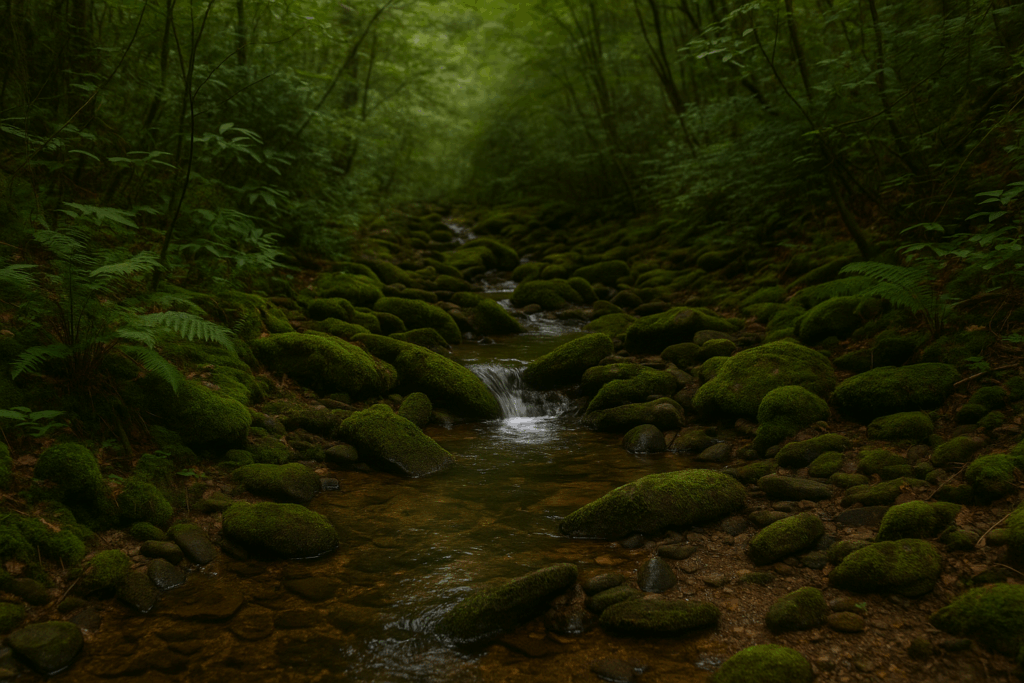There’s something about the South. Not the one tourists see from the highway or through Instagram filters, but the one hidden in folds of rhododendron, somewhere between a forgotten trail and a granite outcrop. That South still flows. And if you follow the flow—quiet, cold, deliberate—it will lead you straight to the heart of trout country.
You don’t start with the river. You start upstream. Always upstream.
The best trout water in North Carolina and Georgia doesn’t brag. It doesn’t post signs or selfies. It trickles down steep hollows and carves out secrets in moss-covered gullies. It’s the barely-visible stream behind your cabin, the one you hear before you see. And it matters more than people think.
These microstreams, born of spring seeps and mountain runoff, feed the great trout rivers of the region—cooling them, oxygenating them, and delivering nutrients that fuel aquatic life. Without them, the Upper Nantahala becomes sluggish. The Tuckasegee flattens. The Tallulah gasps. But with them? These rivers sing.
Upper Nantahala: The Fighter’s Water
Start with the Upper Nantahala, just outside Topton, NC. This is not a lazy river. It’s a fighter—fast, boulder-strewn, and cold even in August. You earn your fish here. Tight quarters. Pocket water. Casts measured in feet, not yards.
The Nantahala is stocked, yes—but don’t let that fool you. Wild rainbows and browns lurk upstream where stocking trucks can’t reach. The real action begins where the side creeks join in—those skinny rills you can cross in a single step. Most anglers ignore them. That’s a mistake.
When you fish here, you’re not just casting into water. You’re casting into a living system. Every inch is a conversation between geology, rainfall, temperature, and trout.
Tuckasegee River: The Generous One
The Tuckasegee—or “Tuck” if you’ve earned it—runs broader, more forgiving. It’s a drift boat dream in the Delayed Harvest stretch near Webster, but it starts off humble in the mountains near Cashiers. The best days on the Tuck come from understanding its source. Up high, it’s a network of small mountain flows, born of granite faces and filtered through peat and pine.
What these streams lack in size, they make up for in clarity and chill. That matters when summer turns hot. Trout know where the cold water is, and they’ll follow it upstream. So should you.
A good angler follows the signposts: a dip in water temps, a trail of caddis husks on a rock, a rising swirl at the mouth of a feeder creek. These aren’t detours. They’re the start of something better.
Tallulah River: Georgia’s Hidden Jewel
Now cross state lines. North Georgia doesn’t always make the national fly fishing lists—but it should. The Tallulah River in Rabun County is proof. Drive far enough down a Forest Service road and you’ll feel it: the hum of real water. It’s remote, yes, but not desolate. And it’s alive.
The upper Tallulah is dotted with plunge pools and undercut banks—ideal wild trout water. Like the Nantahala and Tuckasegee, it thrives because of what feeds it. The small tributaries up near Tate City carry more than water. They carry the promise of wildness.
If you stop and listen, you’ll hear the voice of the stream before you see the fish rise. That’s the rhythm The Call of the Creek is built on.
Why Small Streams Matter
You don’t have to cast here to learn something. Just kneel. Feel the temperature difference between the stream and the air. Watch a stonefly cling to bark. Notice how everything moves quietly but with purpose.
This is the source of it all—not just biologically, but spiritually. In The Call of the Creek, I wrote that most people miss the best water because they never look up. Or down. Or around.
The small Appalachian streams are the bloodstream of the Southern trout experience. They are teachers. And if you listen, they’ll tell you where the best fish are hiding—and why.
The Call of the Creek: A Personal Invitation
The Call of the Creek isn’t just a book about trout fishing—it’s about recovering something that’s been lost. In a world where everything is fast and loud, these Southern streams ask for stillness. They invite you to start small. To slow down. To go upstream.
If you’ve never explored the feeder streams of the Upper Nantahala, the wooded ridges above the Tuckasegee, or the hidden springs of the Tallulah, you’re missing the soul of NC and Georgia trout fishing. And I’d love for you to experience it.
That’s why I wrote the book. Not to teach techniques. Not to brag about miles covered or trout landed. But to answer a calling—a quiet voice that starts in the woods, gains strength with the water, and leads you into the current of something much bigger.
Planning Your Trip: Quick Tips
- Upper Nantahala access: Pull-offs on Wayah Road. Look for cascades and oxygen-rich plunge pools.
- Tuckasegee River: Try the Delayed Harvest section near Dillsboro for numbers, or hike upstream for solitude.
- Tallulah River, GA: Park near Tate City. Hike upstream for wild browns and rainbows. Watch for bears. Bring your camera.
Ready to Answer the Call?
Whether you’re in Asheville or Atlanta, trout country is closer than you think. Don’t wait for perfect gear or a guidebook’s approval. Pick a stream. Start walking. Start listening.
And if you want a companion for the journey, grab a copy of The Call of the Creek. It was written for moments just like these.
